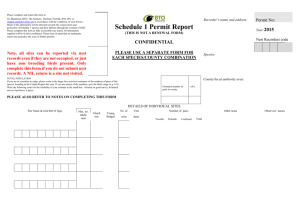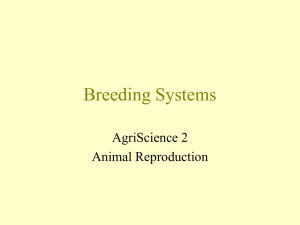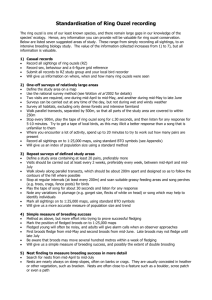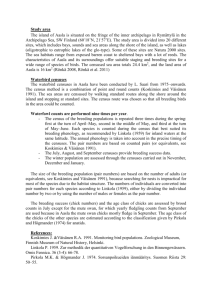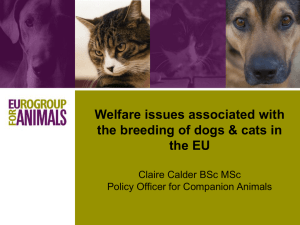Whooping Crane (Grus americana)
advertisement
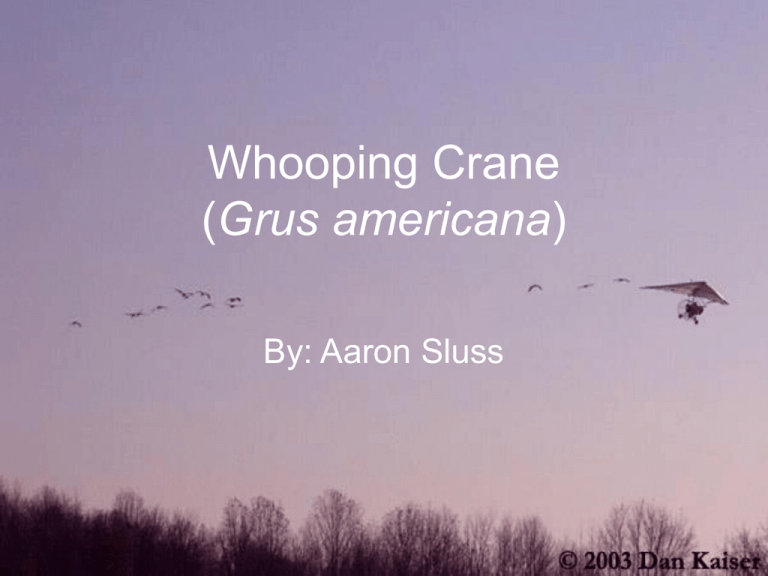
Whooping Crane (Grus americana) By: Aaron Sluss Morphological Characteristics • Tall bird- nearly 5 feet • Adults white with red patch on crown • Long white neck • Dark legs, dark pointed bill, and black facial markings. • In flight, black wingtips are visible • Inner wing feathers droop over the rump, called a" bustle” which distinguishes cranes from herons • Sexes alike Other Characteristics • Adults weigh between 12 and 15 pounds • Wing span of nearly 8 feet • Life Span of 22-24 yrs (wild) • Gets its name from its loud bugle-like trumpeting call ker-loo ker-lee-loo • http://www.learner.org/jnorth/search/CraneNotes 1.html#8 • Heard from 2 miles • Long trachea which coils twice Inside the breast bone Habitat • Whoopers use a variety of habitats for different times in the year. • Breeding: mixed forest and wetlands • Migration: croplands, marshes, and submerged sandbars. • Winter: bays and coastal marshes Feeding Characteristics • Wetlands: feed on clams, insects, fish, frogs, crabs, and crayfish • Uplands: feed on insects, snails, small rodents, and acorns Breeding • • • • • Start pairing on wintering grounds http://whoopers.usgs.gov/videos2.htm Monogamous Don’t start breeding until 4 or 5 years breed in the large marshes adjacent to the Sass, Klewi, Nyarling and Little Buffalo Rivers • each pair establishes a territory of 1.5 square miles. Nesting • Did not know where they nested for years. • Usually nest once, but will nest again if nest is destroyed. May even skip a year. • Nests can be floating or built up from the bottom of the pond. • Nests are usually built of bullrush, sedge or cattail. • Clutch size: 2-with one surviving • Incubation: 1 month. Duties shared by parents Recruitment • Varies greatly from year to year • Low as 12% to highs around 78% • Average of about 45 per cent Factors that affect recruitment • the number of pairs actually nesting • the number of viable eggs produced • weather conditions at time of hatching and during the ensuing weeks • habitat conditions (water levels) • abundance of food • Predators (bobcats) (eagles) Juveniles • Cinnamon and white colored • young remain with their parents for the summer • Parents feed them larval, or inactive, forms of insects such as dragonflies, damselflies, and also snails, clams, leeches, and small fish. • able to fly at about 90 days of age Migration • Usually in groups of less than 10. • Make a 2600 mile trip from Wood Buffalo National Park in Canada to the Aransas National Wildlife Refuge in Texas. • Starts trip in late September and arrives in mid to late October to mid November • Special flying method: uses an energy-efficient combination of spiraling and gliding that allows it to fly nonstop for incredible distances (up to 450 miles). What Happened to the Whooper? • • • Not that many to begin with. Are susceptible to many factors during migration. (Diseases, weather, and drought) Delayed breeding maturity Two main factors that caused rapid decline: 1) man-made changes of habitat (esp. wetland losses) 2) hunting, and feather and egg collecting. Recovery of the Whooper • Migratory Bird treaty Act of 1918 • Wood Buffalo National Park est. in 1922 • In 1937, the Aransas National Wildlife Refuge established. Listed as a Threatened and Endangered species in 1973. Recovery Cont.. • Captive Breeding • Difficult to do because of their sensitivity to humans. (Imprinting) • http://whoopers.usgs.gov/videos2.htm • Remove the “extra egg”. • Artificial insemination • Foster parents Flocks of the Past VS Today's • Estimated that in 1870 there were around 500-1400 birds • Went to a low of 1520 in 1941 • As of 2000 282 in wild and 106 in captivity • More pandas than whoopers What must be done to continue the success • Establishment of another migratory flock • Support of the Canadian public for the management of whooper nests and eggs • Publicity and hunter education Preservation of wetlands along the cranes’ migration route Any Questions??


